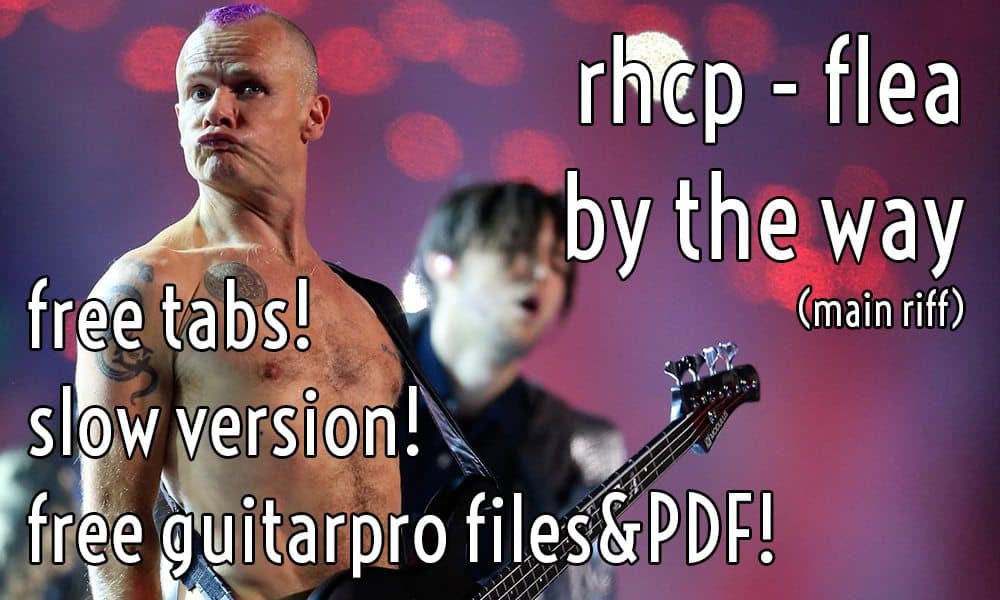Bass Edu
Flea Lesson – RHCP – By the Way (Main Riff)


Flea Lesson – RHCP – By the Way (Main Riff)…
Hi everyone, this lesson turns in a slightly different musical direction than usual on digthatbass. RHCP was my first favorite band – as a teenager when I picked up the bass, all I wanted to play was RHCP and I was playing to their records and DVDs all the time. Their passion, soul, energy and intensity struck me. They seemed like guys who have enormous talents and BIG personalities – yet they were paying attention to each other while playing and they played from their hearts and guts – they improvised, they gave it all, they dared to make mistakes in the process…and it felt true. Yep, it was entertainment too but it was a good one and I have always felt really joyful and energized when I was listening to them. Recently, I have been listening to the Chili Peppers a lot again and I feel the same things and it’s great 🙂 So, thanks for that feeling guys, luckily, these things you never forget – seeing and hearing the joy of playing is always very inspirational to me.
My previous lessons mostly focus jazz or jazz-related stuff, so this lesson might be a surprise to some of you but I encourage you to explore and play different styles and make excursions into different areas – you might get inspired or find the music that you really love playing. Sometimes, a little change can refresh your music and your angle – when you are working to better yourself on the instrument you might get lost accumulating knowledge and practicing difficult stuff – you might be playing theoretically complicated things that impress musicians but you might miss to put your heart in it. Also, getting a taste of something completely different can give you new motivation and drive – so all in all, I encourage you to take a look on this lesson, and notice that sometimes “simple” is not that simple.
By the Way is a great song and it is driven by the pumping bassline of master Flea himself – someone who I don’t have to introduce to anybody. The riff itself is technically not that complicated but the feel and little nuances make it really special and hard to emulate. I have been checking on YouTube but I haven’t really seen guys playing it correctly and that’s why I made this lesson which is also a sort of tribute to Flea and his bass playing. I am 99% sure that this is how he plays it – if not, I hope Flea himself will show me how to do it correctly 🙂
That special feel comes from the low open D ghost notes played throughout the line – in the first bar, the 5th, 7th and 11th note. Basically, those notes are soul of this line – these are the most important when you want to learn this. In the video I talk about the variations (where I hear them on the record and on live versions), so check that out. The sound definitely comes from Flea’s Modulus Bass but you can add compression and a drive/booster to your signal chain and set your bass tone controls to full treble to achieve a similar sound. Also, you have to play as hard as you can this time – dig in, have fun with it and rock that bass!
The video does not intend to violate any laws or copyright, it is to be used for educational purposes (fair use). The original song can be purchased at Amazon and iTunes!
Support Flea and his music and buy the original Red Hot Chili Peppers records.
After a short registration on digthatbass.com, you can download a free GuitarPro5 file and a free PDF as well!
Cheers,
Rajoe
Bass Edu
BASS LINES: Triads & Inversions Part I

Triads & Inversions Part I…
Hello bass players and bass fans! In this issue, we are going to study the triads and their inversions.
It is very important for all bassists to understand and master the triads, but it is even more important to understand their different inversions.
In Part I, we are going to learn what the triad is in fundamental position.
The Formula consists of root, third and fifth.
Degrees of the Triad
Major Triad: 1 – 3 – 5
Minor Triad: 1 – b3 – 5
Diminished Triad: 1 – b3 – b5
Augmented Triad: 1 – 3 – #5
Fig.1 – The C, Cm, Cdim & Caug triads
(Fundamental Position)
Bass Edu
Premiere! Bass Playthrough With Foetal Juice’s Bassist Lewis Bridges – From the Album, Grotesque

Premiere! Bass Playthrough With Foetal Juice’s Bassist Lewis Bridges – From the Album, Grotesque
Bassist Lewis Bridges Shares…
“Gruesome’s sparse intro marks a stark contrast from the intensity of the rest of the album. The original intention was to keep the bass simple but colourful, however as I worked on it, the lines grew more expressive and the more striking flourishes began to emerge. The intensity builds into a harmonic minor passage that takes us into the drop — a signature death grind cacophony. This is where Foetal Juice thrives. You’re getting a full-on right-hand barrage to in the face to take you into a groove-laden mulch-fest.
I owe my throbbing bass tone to the Darkglass Alpha Omega pedal borrowed from our sound engineer, Chris Fielding (ex-Conan), mixed with the clarity of the tried and true Ampeg SVT CL.
As mentioned earlier, colourful basslines are important, especially in a one-guitar band. Chucking some funny intervals and odd flourishes here and there brings life into the brutality. There’s no point sounding brutal if it’s not gonna be fucking evil too!
Recording this playthrough was hard work. This was not the fault of James Goodwin (Necronautical), who was kindly filming and is ace to work with, but because in true Foetal fashion, we had stinking hangovers — and that jam room was hot!”
Follow Online
FB @FoetalJuice
TW @FoetalJuice
IG @foetaljuice
Youtube: @Foetaljuice
Spotify
Foetaljuice.bandcamp.com
Bass Edu
Bass Lines: The Circle

Bass Lines: The Circle…
Hello bass players and fans of bass! This month we’re going to study “The Circle.”
The Circle of Fourths can also be called “The Circle of Fifths or just The Circle.
Practicing the scales, chords, and ideas in general via the circle has been a common practice routine for jazz musicians and highly recommended.
It is a disciplined way of working through all twelve keys.
Plus, many bass root movements to jazz and pop songs move through sections of the circle.
Fig. 1 – “The Circle”

See you next month for more full bass attack!
#bassmusicianmag, #basslines, #bmmbasslines, #groovemaniac, #thecircle, #thecircleoffourths, #thecircleoffifths,#scales & #chords.
Bass Edu
Approach Notes – Part 5

Continuing our lesson of Approach Notes, Part 5…
In continuing with the concept of approach notes being applied to chord tones, this lesson approaches the root, third, fifth, and seventh degree of each arpeggio inversion by incorporating a double chromatic approach from above, and a single chromatic approach from below.
The first examples approach the root of a G major 7th arpeggio as a double chromatic from above and a single chromatic approach from below -before continuing to the third, fifth, seventh, double chromatic from above/ single from below to the root, continue to the third, fifth, and come back down.
The next example approaches the first inversion of G major 7th arpeggio.
A double chromatic from above/ single from below approaches the third, continue to the fifth, seventh, root, double chromatic from above/ single below to the third, continue up to the fifth and seventh, and back down.
The third example approaches a second inversion of a G major arpeggio.
A double chromatic from above/ single from below approaches the fifth, continue to the 7th, root, 3rd, double chromatic from above/ single from below to the 5th, continue to the 7th, root, and back down.
This final example approaches a third inversion of a G major 7th arpeggio.
A double chromatic from above and below approaches the 7th, continue to the root, 3rd, 5th, double chromatic from above and below to the 7th, continue to the root, 3rd, and back down.

Be sure to pace yourself with these lessons to avoid burning out.
Being overly ambitious with your practice schedule can lead to unrealistic expectations. Try learning one approach note concept and one chord type a week. Change your practice routine as necessary and tailor it to your needs as a musician. Good luck!
Bass Edu
BASS LINES – The Blue Notes (Minor Blues Scale)

Hello bass players and bass fans! Happy New Year 2024!
In this issue, we are going to study the blue notes.
In blues, jazz, and rock, a blue note is a note that (for expressive purposes) is sung or played at a slightly different pitch from standard. Typically the alteration is between a quartertone and a semitone, but this varies depending on the musical context.
The blue notes are usually said to be the lowered third(b3), lowered fifth(b5) and lowered seventh(b7) scale degrees. The lowered fifth(b5) is also known as the raised fourth(#4). Though the blues scale has “an inherent minor tonality, it is commonly ‘forced’ over major-key chord changes, resulting in a distinctively dissonant conflict of tonalities”.
Blue notes are used in many blues songs, in jazz, rock and in conventional popular songs with a “blue” feeling.
Formula:
The A Minor Blues Scale
1 – b3 – 4 – (#4/b5) – 5 – b7
A – C – D – (D#/Eb) – E – Bb
The grades(blue notes):
b3, (#4/b5), b7
C, (D#/Eb), Bb
See you next month for more full bass attack!
#bassmusicianmag, #basslines, #bmmbasslines, #groovemaniac, #thebluenotes, #minorbluesscale & #bluesscale
















